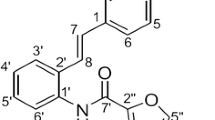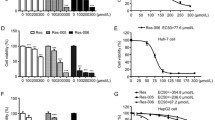Abstract
Based on the potential cancer chemopreventive activity of resveratrol, a trihydroxystilbene with the induction of quinone reductase activity, this study was designed to determine if stilbene-related compounds were inducers of phase II detoxifying metabolic enzyme quinone reductase (QR) in the mouse hepatoma Hepa 1c1c7 cells. Among the thirteen compounds tested, several compounds including 3,4,5,3′,5′-pentamethoxy-trans-stilbene were found to potentially induce QR activity in this cell line. In addition, substitution with 3-thiofurane ring instead of phenyl ring in the stilbene skeleton also exhibited potential induction of QR activity. This result will give primary information to design the potential inducers of QR activity in the stilbene analogs.
Similar content being viewed by others
References
Cheng, L. C., Gerhäuser, C., Song, L. L., Farnsworth, N. R., Pezzuto, J. M., and Kinghorn, A. D., Activity-guided isolation of constituents ofTephrosia purpurea with the potential to induce the phase II enzyme, quinone reductase.J. Nat. Prod., 60, 869–873 (1997).
De Long, M. J., Prochaska, H. J., and Talalay, P., Tissue-specific induction patterns of cancer-protective enzymes in mice by tert-butyl-4-hydroxyanisole and related substituted phenols.Cancer Res., 45, 546–551 (1985).
Cerhäuser, C., You, M., Liu, J., Moriarty, R. M., Hawthorne, M., Mehta, R. G., Moon, R. C., and Pezzuto, J. M., Cancer chemopreventive potential of sulforamate, a novel analogue of sulforaphane that induces phase 2 drug-metabolizing enzymes.Cancer Res., 57, 272–278 (1997).
Grubbs, C., Steele, V. E., Caseblot, T., Juliana, M. M., Eto, I., Whitaker, L. M., Dragnev, K. H., Kelloff, C. L., and Lubet, R. L., Chemoprevention of chemically-induced mammary carcinogenesis by indole-3-carbinol.Anticancer Res., 15, 709–716 (1995).
Gurtoo, H. L., Koser, P. L., Bansal, S. K., Fox, H. W., Sharma, S. D., Mulhern, A. I., and Pavelic, Z. R., Inhibition of aflatoxin B1-hepatocarcinogenesis in rats by β-naphthoflavone.Carcinogenesis, 6, 675–678 (1985).
Jang, M., Cai, L., Udeani, G. O., Slowing, K. V., Thomas, C. F., Beecher, C. W., Fong, H. H., Farnsworth, N. R., Kinghorn, A. D., Mehta, R.G., Moon, R. C., and Pezzuto, J. M., Cancer chemopreventive activity of resveratrol, a natural product derived from grapes.Science, 275, 218–220 (1997).
Kennelly, E. J., Gerhäuser, C., Song, L. L., Graham, J. G., Beecher, C. W. W., Pezzuto, J. M., and Kinghorn, A. D., Induction of quinone reductase by withanolides isolated fromPhysalis philadelphica (tomatillos).J. Agric. Food Chem., 45, 3771–3777 (1997).
Mehta, R. G., Liu, J., Constantinou, A., Thomas, C. F., Hawthorne, M., You, M., Gerhäuser, C., Pezzuto, J. M., Moon, R. C., and Moriarty, R. M. Cancer chemopreventive activity of brassinin, a phytoalexin from cabbage.Carcinogenesis, 16, 399–404 (1995).
Prochaska, H. J., Bregman, H. S., De Long, M. J., and Talalay, P., Specificity of induction of cancer protective enzymes by analogues of tert-butyl-4-hydroxyanisole (BHA).Biochem. Pharmacol., 34, 3909–3914 (1985).
Prochaska, H. J. and Santamaria, A. B., Direct measurement of NAD(P)H:quinone reductase from cells in microtiter wells: a screening assay for anticarcinogenic enzyme inducers.Anal. Biochem., 169, 328–336 (1988).
Prochaska, H. J., and Talalay, P., Regulatory mechanism of monofunctional and bifunctional anticarcinogenic enzyme inducers in murine livers.Cancer Res., 48, 4776–4782 (1988).
Song, LL, Kosmeder, JW 2nd, Lee, S.K., Gerhäuser, C., Lantvit, D., Moon, R. C., Moriarty, R. M., and Pezzuto, J. M., Cancer chemopreventive activity mediated by 4′-bromoflavone, a potent inducer of phase II detoxification enzymes.Cancer Res., 59, 578–85 (1999).
Talalay, P., De Long, M. J. and Prochaska, H. J., Molecular mechanisms in protection against carcinogenesis Cory, J. G., Szentivanyi, A., (Eds.). Cancer Biology and Therapeutics, Plenum Press New York, pp. 197–216, (1981).
Wattenberg, L. W. and Bueding, E., Inhibitory effects of 5-(2-pyrazinyl)-4-methyl-1,2-dithiole-3-thione (oltipraz) on carcinogenesis induced by benzo[a]pyrene, dithylnitrosamine and uracil mustard.Carcinogenesis, 7, 1379–1381 (1986).
Zhang, Y., Kensler, T. W., Cho, C. G., Posner, G. H., and Talalay, P., Anticarcinogenic activities of sulforaphane and structurally related synthetic norbornyl isothiocyanates.Proc. Natl. Acad. Sci. USA, 91, 3147–3150 (1994).
Author information
Authors and Affiliations
Corresponding author
Rights and permissions
About this article
Cite this article
Heo, Y.H., Kim, S., Park, J.E. et al. Induction of quinone reductase activity by stilbene analogs in mouse hepa 1c1c7 cells. Arch Pharm Res 24, 597–600 (2001). https://doi.org/10.1007/BF02975172
Received:
Issue Date:
DOI: https://doi.org/10.1007/BF02975172




